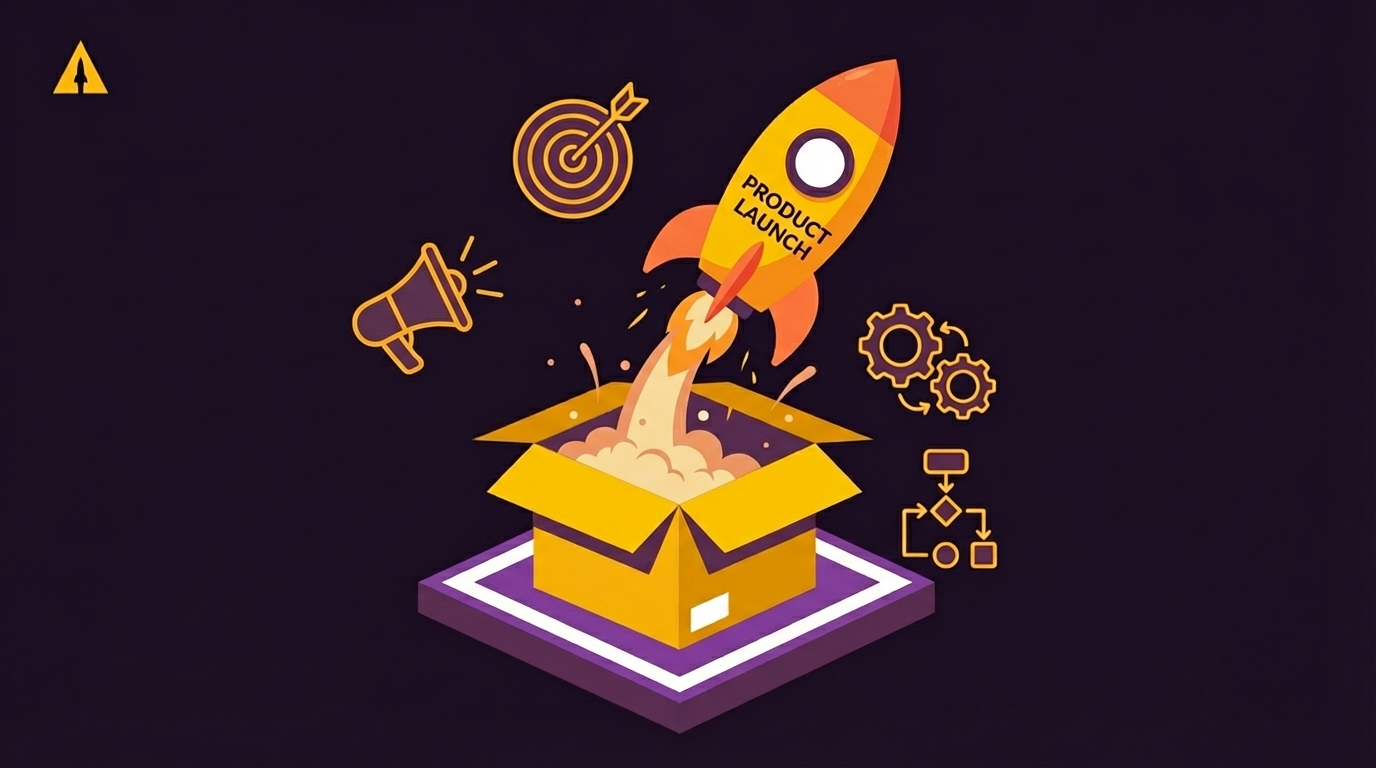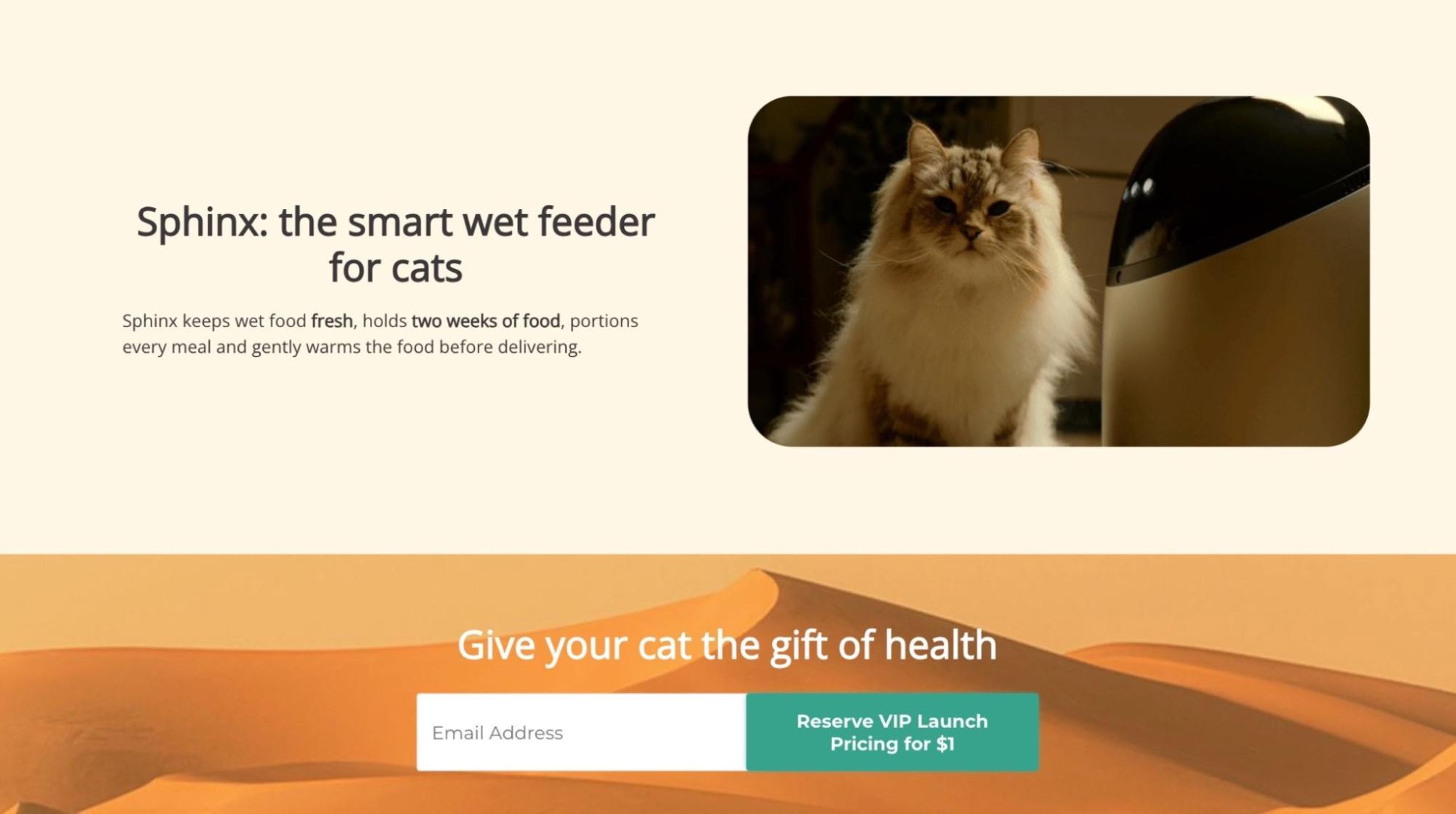
Most product launches fail.
That’s just the reality. Entrepreneurs pour years into developing their products, only to launch to crickets. No sales. No momentum. Just a warehouse full of inventory and a sinking feeling in their gut.
But it doesn’t have to be this way.
Over the last decade, crowdfunding and data-driven planning have completely transformed how smart entrepreneurs bring new products to market. Instead of manufacturing thousands of units and praying people show up to buy, you can now validate demand, build an audience, and generate real revenue before you ever place that big manufacturing order.
My company LaunchBoom has helped over 1,000 entrepreneurs launch their products using this approach. We’ve generated over $175 million in revenue for our clients. And in this guide, I’m sharing the exact five-step product launch strategy we’ve developed so you can copy it and apply it to your own launch.
By the way, you can check out the video version of this article here:
Contents
Key Takeaways
Here’s what you’ll learn in this article:
- Why pre-order product launches minimize risk compared to traditional inventory launches
- The five pillars of a successful product launch strategy that’s generated over $175M in revenue
- Real-world product launch examples with six-figure day-ones
- Tools and frameworks to attract superfans and generate momentum before you launch
- How to create a high-converting reservation funnel that predicts future sales 20-30x better than email collection alone
What Is a Product Launch Strategy?
A product launch strategy is your complete plan for bringing a new product to market successfully.
It’s different from a traditional marketing plan or business plan. While those documents cover broader business operations, a product launch strategy focuses specifically on the tactical steps you’ll take to validate demand, build an audience, and generate sales when you go live.
Think of it as aligning market research, customer insights, and promotional plans to ensure your product doesn’t just exist—it thrives from day one.
Now, there are basically two ways you can launch your product.
On one end, you have the Inventory Launch. This is the traditional approach where you do all your product development, manufacture thousands of units, get tons of inventory sitting in a warehouse, and then do all your marketing. You’re basically praying that people show up and buy your product.
This is really risky.
On the other end, you have the Pre-Order Launch. You still do the product development and get a prototype, but now you do all your marketing around that prototype. You have people pre-order your product before you manufacture it and get all your inventory.
This is way less risky.
At LaunchBoom, we prefer the Pre-Order Launch. You’re getting real revenue, real validation, and real customer feedback before you invest heavily in manufacturing. And the way we do these pre-order launches is by leveraging crowdfunding platforms like Kickstarter and Indiegogo.
Our 5-Step Product Launch Strategy
Let me walk you through the exact five steps we use at LaunchBoom. This is the framework that’s responsible for over $175 million in revenue for our clients.
1. Superfan Positioning
Superfan positioning is all about showcasing the value of your product to the person who’d love it.
Notice I said “superfan” not “customer” or “buyer persona.” This is a smarter, deeper evolution of traditional persona development. You’re not just looking for people who might buy your product. You’re identifying the people who will absolutely love it, tell all their friends about it, and become advocates for your brand.
These are your superfans.
Let me show you how to build a superfan profile using Sphinx as an example.

Sphinx is an automatic cat feeder that uses wet cat food and facial recognition technology
Here’s the framework for researching and writing a superfan profile:
Step 1: Target the Right Audience
Give your superfan a name and age, then answer these questions:
- What do they do for fun?
- Who do they buy from?
- Who do they follow online?
- What do they watch and listen to?
- What frustrates them most about current solutions?
For Sphinx, their superfan looks like this:
- What do they do for fun? Goes to coffee shops, plays board games and video games.
- Who do they buy from? They buy from brands like Apple, Dyson, and Tuft and Paw.
- Who do they follow online? They follow tech influencers like MKBHD and Engadget.
- What do they watch and listen to? They watch sci-fi, listen to indie and EDM music, and read Brandon Sanderson.
- What frustrates them most about current solutions? They’re frustrated because they’ve tried other automatic cat feeders, but none of them work well with wet cat food. They want to give their cat a premium experience because they love their kitty.
You’re probably getting an idea of who this superfan is. They’re kind of a tech nerd. But they’re a little bit more affluent because they buy from nicer brands and follow these tech influencers.
Step 2: Explain Why They’ll Love Your Product
Now that you know who your superfan is, you need to explain your product to them. Start simple by answering:
What’s the product in plain English?
Don’t overthink this part. Just describe it like you’re telling a friend.
For Sphinx: “It’s an automatic wet food feeder for cats. It uses facial recognition to feed cats at the right time.”
That’s it. Not perfect, but it’s a good start.
Next answer the question:
What are the top three ways the product is way better than the competition?
If you don’t have three things that are way better than everything else out there, you probably should go back to the drawing board. To be marketable, you have to have something that grabs someone’s attention. They’re like, “Woah, that’s actually different.”
For Sphinx, those three things were:
- Keeps wet cat food fresh for 2 weeks
- Doesn’t overfeed cats because it uses facial recognition to learn feeding schedules
- Supports multi-cat households by recognizing individual cats and portioning meals accordingly
This product positioning strategy becomes the foundation for everything else. Your headline, your sub-headline, your ads, your campaign page – it all flows from this superfan positioning work.
Based on everything we just wrote down, here was the headline and sub-headline for Sphinx:
Headline: The Smart Wet Feeder for Cats
Sub-headline: Sphinx keeps wet food fresh, holds two weeks of food, portions every meal, and gently warms the food before delivering.
Simple. Clear. Not trying to be too clever. But people understand what it is and it grabs their attention.
2. Create a Reservation Funnel
A reservation funnel is designed to filter out highly engaged buyers by using small-dollar deposits.
Instead of just collecting emails, you’re asking people to put down $1 to hold a huge discount – like $150 off when the product launches. And here’s why this is so powerful: those that put down $1 are usually 20 to 30 times more likely to buy than someone that just gives you their email address.
Think about it. They have to pull out their credit card after they’ve just learned about your product. They must be really interested.
Here’s how to build a reservation funnel step-by-step:
Step 1: Landing Page

Create a simple landing page that collects an email. You can use tools like Shopify, ClickFunnels, Lead Pages, or Wix. At LaunchBoom, we built our own software called LaunchKit that makes this really easy, but you can use whatever landing page builder you’re comfortable with.
For Sphinx, their landing page had an autoplay video at the top showing the product in action. Then they kept the messaging simple and focused on benefits. They dedicated individual sections to each major feature—wet cat food on your cat’s schedule, keeps food fresh for 2 weeks, and supports multiple cats.
Keep it mobile optimized because that’s probably where most of your traffic will come from. And don’t overdo it with copy. I always see people add way too much text to these pages.
Step 2: Reservation Page

After someone gives you their email, you take them to a page that says: “Lock in our best available discount by reserving today.”
This is where the reservation funnel really becomes a reservation funnel. You’re explaining how a small monetary commitment will reserve the best deal when you launch.
Step 3: Checkout

Keep it simple. Get their credit card information. That’s it.
Step 4: Thank You Page

Confirm their reservation and give them next steps. Maybe send them to follow your Kickstarter or Indiegogo page.
Pair With Email Marketing
You also want to set up automated email sequences. When someone gives you their email but doesn’t put down the deposit, send them an email reminding them about the discount they can lock in for just $1.
When someone does become a VIP by putting down the dollar, send them a welcome message from the founder and encourage them to follow your campaign page on Kickstarter or Indiegogo.
You can use Mailchimp or any email marketing software for this. Keep it simple.
3. Drive Targeted Traffic
Now that you have your reservation funnel built, you need to drive traffic to it.
Our preferred way to do this is using Meta ads (Facebook and Instagram). I always get the question about other platforms like TikTok, Google, YouTube, Reddit. And yes, you can test those. But we still find that Meta ads perform the best when it comes to both lead generation and getting sales for new e-commerce products.
You do need an ad budget to do this. But we haven’t found a way that does a better job of actually scaling and spending money most effectively to get you the highest ROI.
What Makes a Good Ad
There are three components:
- Good imagery
- Good copy
- Good targeting
And it goes in that order in terms of importance.
Imagery: Often it isn’t these super well-produced images that work really well. Even just photos of the product on a white or colored background are usually some of the top performing ads. The hero of the image should be the product itself.
For Sphinx, one of their best performing ads showed their device next to a cat. It definitely stopped the scroll because you have this tech device next to this cat, and it grabs attention.

Copy: Here’s an ad template that works really well:
Start with a bold claim: “Introducing Sphinx: the world’s smartest wet feeder for cats”
Then add a bulleted list of features and benefits:
- Refrigerated 50oz capacity
- Load your own food
- Gently warmed meals to blood temperature
- Automatic weight loss plan
For the headline (the text that appears below the image), make bold statements: “A Revolution in Cat Ownership. No Smell. No cleanup. Meals your cats LOVE”
This ad got tons of engagement—likes, shares, comments. And it was the ad that drove the most amount of emails and reservations.
Targeting: Meta has taken away a lot of targeting options, which is actually good for new advertisers because there are fewer ways to mess up. But you still want to give Meta suggestions on who to target.
Use detailed targeting based on interests. Remember all those questions we asked about the superfan? Who do they follow online? What do they buy? That becomes really useful here.
For Sphinx, they targeted interests like: litter box, Think Geek, Persian cat, Tech Radar. It’s a mixture of cat interests and tech interests.

Meta uses these suggestions and then expands from there using their AI to find your audience.
4. Build a High-Converting Campaign Page
Now you need to create your campaign page on Kickstarter or Indiegogo.
Think of it as an extended landing page. You’re taking everything you learned from your reservation funnel – what messaging worked, what features resonated – and using those insights to craft a campaign page that converts.
There are two main assets you need:
Campaign Video
This should be 60 to 90 seconds. Don’t treat it like a micro-documentary about your founder story. Treat it like an ad.
Here was Sphinx’s video:
Their video had a great hook. Immediately you see the cat talking about the problem—food that’s too dry, too cold, too old. Then at around 12 seconds into the video, the Sphinx product comes in as the solution.
Get into the actual product within the first 5 to 10 seconds. Structure it as: hook, problem, solution, benefits, call to action.
You don’t need a super expensive production. Keep your costs down by keeping it concise and focused on the product.
Campaign Page
This is basically a really long landing page. And what’s cool is you’ve already tested messaging on your reservation funnel, so you know what works.

For Sphinx, they used the same headline that worked on their landing page: “The Smart Wet Feeder for Cats.” The sub-headline was basically the same too. That’s because it was heavily tested in the pre-launch.
My recommendation is to just go look at top performing campaigns on Kickstarter or Indiegogo, especially in your niche. Model what they’re doing. Don’t copy them directly, but ask: “What are they doing here? How can I model this for my product?”
That will get you 80-90% of the way there. You’re just filling in with your copy and imagery.
This aligns perfectly with your new product marketing plan – you’re using data from your pre-launch to inform every decision you make on your campaign page.
5. Launch and Leverage Momentum
This part is kind of easy because you’ve done all the hard work in the pre-launch.
You’ve positioned your product. You’ve built your reservation funnel. You’ve driven traffic to it. You’ve built up your email list and gotten those $1 reservations. You’ve created your campaign page and video.
Now it’s essentially pushing the launch button and sending an email.
For Sphinx, they sent an email to everyone who put down the $1 deposit. The email reminded them: “Hey, you reserved your $150 discount. We’re now live on Kickstarter. Click here to claim it.”

They also sent a separate email to people who gave their email but didn’t put down the deposit, offering them a smaller discount.
The result? $260,000 in one day.
That’s a lot of money. And it’s because they had all those emails and reservations ready to go.
But the launch day is just the beginning. You keep the momentum going by:
- Continuing to run ads to drive traffic to your campaign page
- Sending regular email updates to your list
- Re-targeting people who visited but didn’t back
And here’s where Kickstarter really shines: it’s a marketplace. There are tons of early adopter types looking for new products to pre-order. For Sphinx, 20% of all funds raised came from Kickstarter itself – over $100,000 they didn’t have to pay for except for the 5% platform fee.
Also, when you send more traffic to a page that already has $200,000 in pre-sales, people are much more likely to back the project because they see all that social proof.
This creates a feedback loop. More backers lead to more in-platform discovery, which leads to more backers, which leads to more social proof.
Sphinx ultimately raised $544,516 in 30 days.
How Our Strategy Compares to a Traditional Go to Market Strategy
A traditional go to market strategy is typically broader – covering sales channels, operations, distribution, and marketing across your entire business.
A product launch strategy like ours focuses specifically on pre-launch and launch execution.
Here’s how they compare:
Traditional Go to Market Strategy:
- Manufacture inventory first
- Higher upfront costs
- Greater financial risk
- Limited early validation
- Broader operational focus
LaunchBoom’s 5-Step Product Launch Strategy:
- Validate with pre-orders first
- Lower upfront costs
- Minimal financial risk
- Early data collection and validation
- Laser-focused on launch execution
The biggest difference? Early data collection. With our approach, you’re learning what messaging works, who your superfans are, and what features resonate before you invest heavily in manufacturing. You’re using a lean budget to generate real revenue and validation.
Then you can scale with confidence.
Traditional strategies often require you to make big bets based on assumptions. Our product launch strategy lets you make small bets, collect data, and make informed decisions before the big manufacturing commitment.
Final Thoughts
Here’s what I want you to remember: a proven pre-order launch model mitigates risk.
Instead of manufacturing thousands of units and hoping people show up, you’re building an audience, generating real revenue, and validating demand before you place that big order. You’re identifying your superfans early. You’re testing messaging and positioning. You’re creating high-converting assets based on real data.
By the time you actually launch, you’re not guessing. You know what works.
This is how you launch with clarity and confidence.
If you want to dive deeper into this system, I’d recommend grabbing a free copy of my Quickstarter guide below.
Product Launch Strategy: Frequently Asked Questions
What Is the Difference Between a Product Launch and a Go to Market Strategy?
A go to market strategy is broader—it covers your entire approach to bringing a product to market, including sales operations, distribution channels, partnerships, and long-term marketing.
A product launch strategy focuses specifically on the tactical steps you’ll take during pre-launch and launch. It’s about generating momentum, building an audience, and driving sales in those critical first weeks or months.
Think of it this way: your go to market strategy is your overall business plan for the product. Your product launch strategy is your game plan for launch day and the weeks leading up to it.
What Should Be Included in a Product Launch Checklist?
A solid product launch checklist should include:
- Market research and competitive analysis
- Superfan positioning and messaging development
- Reservation funnel creation (landing page, reservation page, checkout, thank you page)
- Email marketing automation setup
- Ad creative development (images, copy, video)
- Ad testing and optimization
- Campaign page creation on Kickstarter or Indiegogo
- Campaign video production
- Launch date goal setting
- Launch day email sequences
- Post-launch marketing plan
The key is to work backwards from your launch date. If you’re launching in 8 weeks, map out what needs to happen each week to be ready.
How Do I Create a New Product Marketing Plan?
Creating a new product marketing plan starts with understanding your audience deeply.
First, define your superfan. Who will absolutely love this product? What do they care about? Where do they spend time online?
Second, choose your channels. For most physical products, Meta ads (Facebook and Instagram) perform best for driving awareness and conversions. But you might also consider email marketing, influencer partnerships, PR, or content marketing depending on your product and audience.
Third, plan your content. What messaging will resonate? What features and benefits matter most? How will you communicate value?
Fourth, integrate with your product launch strategy. Your marketing plan should support your pre-launch and launch activities—driving traffic to your reservation funnel, building your email list, and converting backers on launch day.
Set specific goals, timelines, and budgets for each channel. Track performance. Adjust based on what’s working.
What Is the Ideal Product Launch Timeline?
The ideal product launch timeline varies based on your product readiness and team resources, but here’s a general framework:
Weeks 1-2: Research and Positioning
- Develop superfan positioning
- Finalize messaging and positioning
- Competitive research
Weeks 3-4: Build
- Create reservation funnel
- Set up email automation
- Develop initial ad creative
Weeks 5-6: Traffic and Testing
- Launch reservation funnel
- Start running Meta ads
- Test different ad creative and audiences
- Optimize based on performance
Weeks 7-8: Campaign Creation
- Build Kickstarter or Indiegogo campaign page
- Produce campaign video
- Finalize all launch assets
Week 9: Launch
- Send launch emails
- Convert reservations to backers
- Drive ongoing traffic to campaign
This is a 9-week timeline, but some teams move faster (6 weeks) and others need more time (12 weeks). The key is to not rush the pre-launch phase. The data you collect during weeks 5-6 is critical for a successful launch.
What Is Product Positioning Strategy and Why Does It Matter?
Product positioning strategy involves clearly defining how your product solves a specific pain point for a specific user.
It’s not just about features. It’s about communicating value in a way that resonates with your superfan. It’s about answering: Why should someone care about this product? What makes it different? Who is it for?
This matters because your positioning becomes the foundation for everything else—your ad targeting, your messaging, your campaign page copy, your video script.
If you don’t nail your positioning, your marketing won’t work. You’ll be talking to the wrong people or saying the wrong things to the right people.
That’s why Superfan Positioning is step one in our framework. Get this right, and everything else becomes easier. Get this wrong, and you’ll struggle no matter how much money you spend on ads or how good your product is.
Your product positioning strategy should inform every marketing decision you make.






